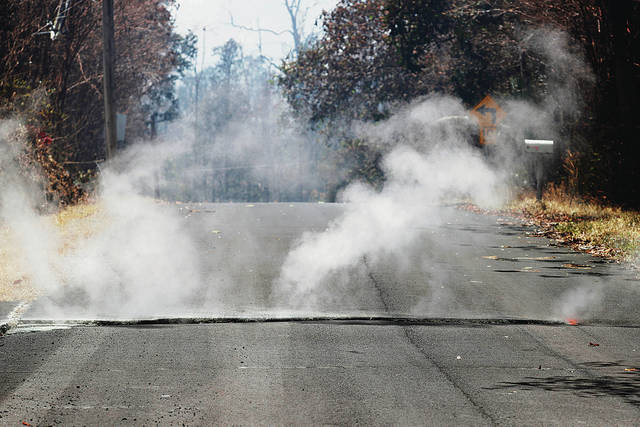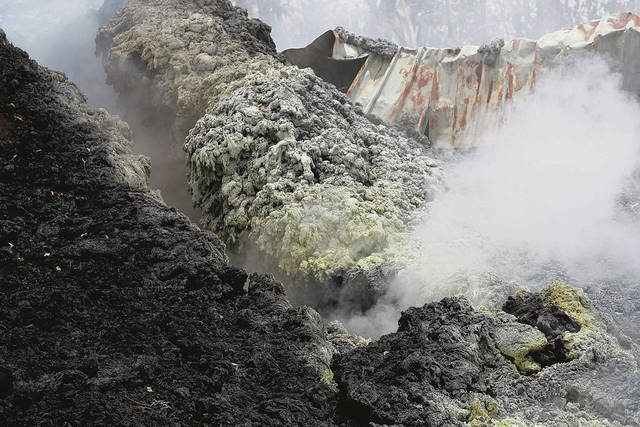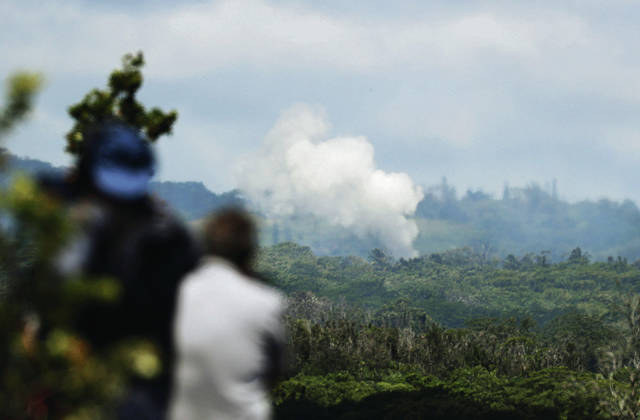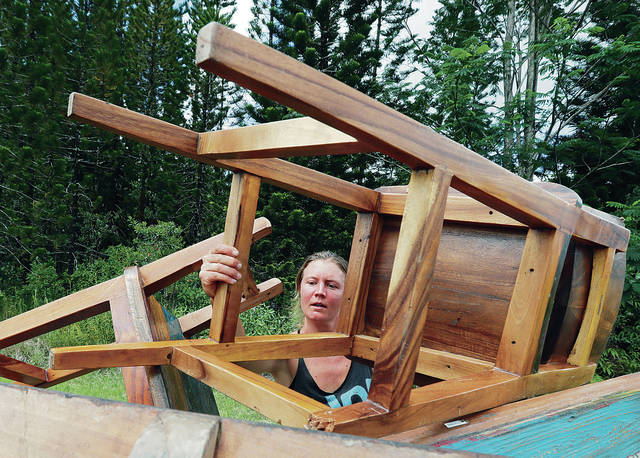Escape road threatened, geothermal wells to be killed as lava approaches

CINDY ELLEN RUSSELL / CRUSSELL@STARADVERTISER.COM
Sulfur dioxide fanned out of cracks in the asphalt near a home at 133585 Moku St. in Leilani Estates on Monday.

CINDY ELLEN RUSSELL / CRUSSELL@STARADVERTISER.COM
Above, sulfur had begun to encrust the lava, which ultimately consumed a Moku Street home on the property.

CINDY ELLEN RUSSELL / CRUSSELL@STARADVERTISER.COM
Sulfur dioxide rose from Fissure 17 from ongoing volcanic activity as seen from Highway 137, Kalapana-Kapoho Road, during a media tour with the National Guard on Monday.

CINDY ELLEN RUSSELL / CRUSSELL@STARADVERTISER.COM
Lea Taylor replaced a chair from the bed of her truck after it fell while driving on Pahoa Bypass Road. Taylor was moving the personal belongings of a friend who is currently off island and whose home is right next to encroaching lava.




HILO >> Lava from Kilauea Volcano on Monday was slowly approaching a coastal highway that is one of the last evacuation routes from the Kalapana, Opihikao and Kapoho areas, and volcanic emissions triggered a “condition red” alert in Lanipuna Gardens because of potentially lethal air quality.
Lava flows from an opening in the ground that scientists have labeled as Fissure 17 reached within 1.3 miles of coastal Highway 137, but by late afternoon, after six hours, had progressed only two-tenths of a mile. Earlier in the day it had been moving downhill at a rate of two-tenths of a mile every 3-1/2 hours.
>> LIVE: Webcam images from Halemaumau at Kilauea
>> Ash plume heads to Pahala after rock falls, gas explosions in Halemaumau Crater
>> Escape road threatened, geothermal wells to be killed as lava approaches
>> Officials seek to shore up Pahoa lifelines, Mayor Kim says
>> Tourism losses mount across the Big Island
>> Evacuees get a brief respite from Kilauea’s eruption
>> Video: Gov. David Ige gives May 14 Kilauea update
>> Photos: Residents prepare for the worst as more fissures open
>> Photos: Tourists stay despite eruption threats from Kilauea
COMPLETE KILAUEA COVERAGE
Star-Advertiser volcano coverage
Kilauea Volcano YouTube playlist
Scientists with the U.S. Geological Survey said the active flow has been releasing jets of gases so loud that observers flying over the area could hear it over the sound of helicopter rotors.
In a related development, authorities announced they are moving forward with a plan to kill three active geothermal wells on the Puna Geothermal Venture site by injecting them with cold water and sealing them with iron plugs. Tom Travis, administrator of the Hawaii Emergency Management Agency, said the effort to pump cold water in the wells could begin as early as today or Wednesday.
Don't miss out on what's happening!
Stay in touch with breaking news, as it happens, conveniently in your email inbox. It's FREE!
“Our way forward is to kill — and maintain kill — on all of the geothermal wells,” he said. That involves using the weight of the cold water to suppress steam and hot water in the wells, and then installing plugs into the wells. Until the plugs are installed, cold water will need to be injected repeatedly, he said.
The PGV plant, which had supplied an estimated 25 percent of the island’s energy, was shut down soon after the Leilani Estates lava outbreak began May 3. Travis said it is possible that the wells could be made functional again, but “that’s a question for another day.”
Those wells are in the general area where a 19th fissure opened at Lanipuna Gardens on Monday morning, and Gov. David Ige told reporters he authorized funding to deliver special equipment that may be needed to secure the wells.
“Our first and foremost priority is to ensure that we can keep the community safe,” Ige said. “If that means we have to fly in and expedite the equipment, then we’re going to do it.” The news that the wells would be killed was greeted with relief by some.
Cindy Mata, a Nanawale Estates resident, said she doesn’t believe the geothermal plant had the proper closing procedures in place and moved too slowly to remove explosive pentane gas. She said the plant shouldn’t be allowed to operate after this threat passes because of the time it took for them to remove the gas after the first fissure.
“Why wait for the last minute?” she asked. “We’re talking about citizens.”
Sylvie Gendron, a 57-year-old Kapoho Beach Lots resident, welcomed the news that the wells would be killed. “It’s always been scary,” she said.
With the lava flow now approaching the coastal highway and Kilauea Volcano opening new fissures daily, the state is also hurrying to make improvements to potential evacuation routes.
Ed Sniffen, deputy director of the state Department of Transportation, said reopening Highway 130 is now a top priority, and Hawaii island Mayor Harry Kim announced Monday night the highway would be open by today.
That highway is the highest-capacity route in and out of the Kalapana area, serving the communities of Kaimu, Opihikao and the Seaview Estates and Black Sand Beach subdivisions, but state officials announced May 7 that it was closed between Pahoa and Old Kalapana Road because of widening cracks in the pavement at mile markers 14.4 and 14.6.
The closure of Highway 130 prompted state crews to drop gravel and make other improvements to Highway 137, a partially paved coastal road that could serve as another emergency route out of Lower Puna.
However, on Monday USGS scientists reported lava from Fissure 17 appeared to be moving along the southern edge of a 1955 lava flow, which may be effectively steering the fresh lava to the east and Highway 137. “Now that we see the risk extending towards (Highway) 137, if that gets cut off, then the route has got to go back to (Highway) 130 again,” Sniffen said. “So, we’re looking at options to minimize any risk at 130.”
In the near term the state might drop metal plates over the cracks in Highway 130 and also might install a monitoring system involving sensors or cameras so the road can be closed quickly if it deteriorates further, Sniffen said.
Another possibility would be to use prefabricated concrete slabs that can resist heat of up to 2,000 degrees to build a bridge over any hazard that threatens Highways 130 or 137, and there’s also the possibility of reopening Chain of Craters Road leading to Hawai‘i Volcanoes National Park, he said.
Civil Defense officials announced that the Hawaii County Fire Department detected high levels of sulfur dioxide gas Monday afternoon from fissures in the southeastern area of Lanipuna Gardens, which already was under a mandatory evacuation. Authorities, however, warned anyone who remained behind of immediate health danger — including choking and inability to breathe.
County spokeswoman Janet Snyder said Monday morning there were also “really high” levels of volcanic gases in the Opihikao and Seaview subdivision areas, but not at levels high enough to trigger evacuation.
The National Weather Service issued an alert through Monday evening for residents in southern areas of the Big Island who could be affected by “very light ashfall” from Halemaumau Crater on Kilauea’s summit, which released a burst of volcanic emissions at about 9 a.m. Monday that was visible on satellite and web cameras.
Geologists with the Hawaiian Volcano Observatory have been watching the summit crater for what could be a much larger series of steam-driven explosions of ash and rock when the crater’s lava lake falls below the water table.
Star-Advertiser reporter Rob Shikina contributed to this report.



